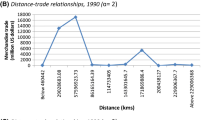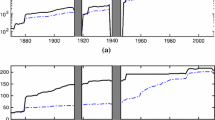Abstract
The gravity model serves as a multifaceted instrument with applicability across various empirical domains. In the realm of international macroeconomics, it is often employed to assess the implications of trade agreements, exchange rate fluctuations, currency unions, the ‘border effect,’ the utilization of shared or related languages, and a diverse array of more specialized applications. This paper presents a critical analysis of the evolution of gravity models in international trade by examining methodological advancements and empirical successes. Our primary focus lies in the underdeveloped concept of distance between two economies. The most straightforward and frequently employed approach to measuring distance involves the use of countries’ capital cities. However, given the rapid progress in data science and emerging technologies, our study integrates previously inaccessible digital information, such as the actual distances between two ports. This methodological enhancement allows for the (1) reconfiguration of the gravity model using real-time data as opposed to annual data, and (2) estimation that, contrary to popular belief, distance is not the most critical determinant; rather, it is time. Time delays in international trade correspond to a country distancing itself from its trading partners beyond what geographical factors dictate. By harnessing the power of data science and novel technologies, this research illuminates the potential to reinvent the gravity model and provide a more accurate understanding of the complex relationships between economies in the global trade landscape.
Access this chapter
Tax calculation will be finalised at checkout
Purchases are for personal use only
Similar content being viewed by others
References
Baier, S.L., Bergstrand, J.H.: Do free trade agreements actually increase members’ international trade? J. Int. Econ. 71(1), 72–95 (2007). https://doi.org/10.1016/j.**teco.2006.02.005
Head, K., Mayer, T.: Chapter 3—Gravity equations: workhorse, toolkit, and cookbook. In: Gopinath, G., Helpman, E., Rogoff, K. (eds.) Handbook of International Economics, vol. 4, pp. 131–195. Elsevier (2014). https://doi.org/10.1016/B978-0-444-54314-1.00003-3
Silva, J.M.C.S., Tenreyro, S.: The log of gravity. Rev. Econ. Stat. 88(4), 641–658 (2006). https://doi.org/10.1162/rest.88.4.641
Tinbergen, J.: Sha** the World Economy: Suggestions for an International Economic Policy. The Twentieth Century Fund, New York, NY (1962)
Poyhonen, P.: A Tentative Model for the Volume of Trade Between Countries, vol. 90. Weltwirtschaftliches Archiv (1963)
Linnemann, H.: An Econometric Study of International Trade Flows. Holland Publishing, Amsterdam (1966)
Anderson, J.E., van Wincoop, E.: Gravity with gravitas: a solution to the border puzzle. Am. Econ. Rev. 93(1), 170–192 (2003). https://doi.org/10.1257/000282803321455214
McCallum, J.: National borders matter: Canada-U.S. regional trade patterns. Am. Econ. Rev. 85(3), 615–623 (1995)
Anderson, J.E.: A theoretical foundation for the gravity equation. Am. Econ. Rev. 69(1), 106–116 (1979)
Deardorff, A.: Testing trade theories and predicting trade flows. In: Handbook of International Economics. Elsevier. [Online]. https://econpapers.repec.org/bookchap/eeeintchp/1-10.htm (1984). Accessed 24 Apr. 2023
Bergstrand, J.H.: The gravity equation in international trade: some microeconomic foundations and empirical evidence. Rev. Econ. Stat. 67(3), 474–481 (1985). https://doi.org/10.2307/1925976
Bergstrand, J.H.: The generalized gravity equation, monopolistic competition, and the factor-proportions theory in international trade. Rev. Econ. Stat. 71(1), 143–153 (1989). https://doi.org/10.2307/1928061
Bergstrand, J.: The Heckscher-Ohlin-Samuelson model, the Linder hypothesis and the determinants of bilateral intra-industry trade. Econ. J. 100(403), 1216–1229 (1990)
Helpman, E., Krugman, P.: Market Structure and Foreign Trade: Increasing Returns, Imperfect Competition, and the International Economy. MIT Press, Cambridge, MA (1985)
Trefler, D.: The case of the missing trade and other mysteries. Am. Econ. Rev. 85(5), 1029–1046 (1995)
Armington, P.S.: A theory of demand for products distinguished by place of production (Une théorie de la demande de produits différenciés d’après leur origine) (Una teoría de la demanda de productos distinguiéndolos según el lugar de producción). Staff Pap. Int. Monet. Fund 16(1), 159–178 (1969). https://doi.org/10.2307/3866403
Leamer, E., Levinsohn, J.: International trade theory: the evidence. In: Handbook of International Economics. Elsevier. [Online]. https://econpapers.repec.org/bookchap/eeeintchp/3-26.htm (1995). Accessed 19 Apr. 2023
Krugman, P., Cooper, R.N., Srinivasan, T.N.: Growing world trade: causes and consequences. Brook. Pap. Econ. Act. 1995(1), 327–377 (1995). https://doi.org/10.2307/2534577
Eaton, J., Kortum, S.: Technology, geography, and trade. Econometrica 70(5), 1741–1779 (2002)
Redding, S., Venables, A.J.: Economic geography and international inequality. J. Int. Econ. 62(1), 53–82 (2004). https://doi.org/10.1016/j.**teco.2003.07.001
Chaney, T.: Distorted gravity: the intensive and extensive margins of international trade. Am. Econ. Rev. 98(4), 1707–1721 (2008). https://doi.org/10.1257/aer.98.4.1707
Helpman, E., Melitz, M., Rubinstein, Y.: Estimating trade flows: trading partners and trading volumes*. Q. J. Econ. 123(2), 441–487 (2008). https://doi.org/10.1162/qjec.2008.123.2.441
Melitz, M.J., Ottaviano, G.I.P.: Market size, trade, and productivity. Rev. Econ. Stud. 75(1), 295–316 (2008). https://doi.org/10.1111/j.1467-937X.2007.00463.x
Petroulas, P.: The effect of the euro on foreign direct investment. Eur. Econ. Rev. 51(6), 1468–1491 (2007)
Warin, T., Wunnava, P.V., Janicki, H.P.: Testing Mundell’s Intuition of Endogenous OCA Theory*. Rev. Int. Econ. 17(1), 74–86 (2009). https://doi.org/10.1111/j.1467-9396.2008.00802.x
Harrigan, J.: Openness to trade in manufactures in the OECD. J. Int. Econ. 40(1–2), 23–39 (1996)
Baldwin, R., Taglioni, D.: Trade effects of the euro: a comparison of estimators. J. Econ. Integr. 22(4), 780–818 (2007)
Kiviet, J.F.: On bias, inconsistency, and efficiency of various estimators in dynamic panel data models. J. Econ. 68(1), 53–78 (1995). https://doi.org/10.1016/0304-4076(94)01643-E
Romalis, J.: NAFTA’s and CUSFTA’s impact on international trade. Rev. Econ. Stat. 89(3), 416–435 (2007)
Hallak, J.C.: Product quality and the direction of trade. J. Int. Econ. 68(1), 238–265 (2006). https://doi.org/10.1016/j.**teco.2005.04.001
Rose, A.K., Lockwood, B., Quah, D.: One money, one market: the effect of common currencies on trade. Econ. Policy 15(30), 9–45 (2000)
Mundell, R.: A plan for a European currency. In: The Economics of Common Currencies—Proceedings of the Madrid Conference on Optimum Currency Areas, Allen and Unwin, pp. 114–132 (1973)
Gómez-Herrera, E.: Comparing alternative methods to estimate gravity models of bilateral trade. Empir. Econ. 44(3), 1087–1111 (2013)
Gourieroux, C., Monfort, A., Trognon, A.: Pseudo maximum likelihood methods: theory. Econometrica 52(3), 681–700 (1984). https://doi.org/10.2307/1913471
Bosquet, C., Boulhol, H.: Applying the GLM variance assumption to overcome the scale-dependence of the negative binomial QGPML estimator. Econ. Rev. 33(7), 772–784 (2014)
Westerlund, J., Wilhelmsson, F.: Estimating the gravity model without gravity using panel data. Appl. Econ. 43(6), 641–649 (2011). https://doi.org/10.1080/00036840802599784
Martin, W., Pham, C.S.: Estimating the gravity model when zero trade flows are frequent and economically determined. Appl. Econ. 52(26), 2766–2779 (2020). https://doi.org/10.1080/00036846.2019.1687838
Head, K., Mayer, T., Ries, J.: The erosion of colonial trade linkages after independence. J. Int. Econ. 81(1), 1–14 (2010). https://doi.org/10.1016/j.**teco.2010.01.002
Felbermayr, G., Kohler, W., Felbermayr, G.J.: Exploring the intensive and extensive margins of world trade, CESifo, CESifo working paper series 1276. [Online]. https://econpapers.repec.org/paper/cesceswps/_5f1276.htm (2004). Accessed 19 Apr 2023
Frankel, J., Stein, E., Wei, S.-J.: Trading blocs and the Americas: the natural, the unnatural, and the super-natural. J. Dev. Econ. 47(1), 61–95 (1995)
Egger, P., Pfaffermayr, M.: The proper panel econometric specification of the gravity equation: a three-way model with bilateral interaction effects. Empir. Econ. 28(3), 571–580 (2003)
Author information
Authors and Affiliations
Corresponding author
Editor information
Editors and Affiliations
Rights and permissions
Copyright information
© 2024 The Author(s), under exclusive license to Springer Nature Switzerland AG
About this chapter
Cite this chapter
Warin, T., Stojkov, A. (2024). Reinventing the Gravity Model: The Significance of Real-Time Data and Time-Related Factors in International Trade. In: Pellat, G., Zafiroski, J., Šuplata, M. (eds) Cooperation and Enlargement: Two Challenges to be Addressed in the European Projects—2022. Studies in Systems, Decision and Control, vol 500. Springer, Cham. https://doi.org/10.1007/978-3-031-42253-9_6
Download citation
DOI: https://doi.org/10.1007/978-3-031-42253-9_6
Published:
Publisher Name: Springer, Cham
Print ISBN: 978-3-031-42252-2
Online ISBN: 978-3-031-42253-9
eBook Packages: EngineeringEngineering (R0)




